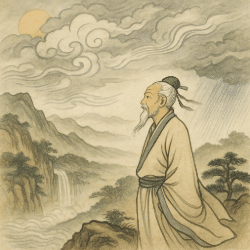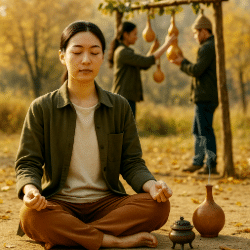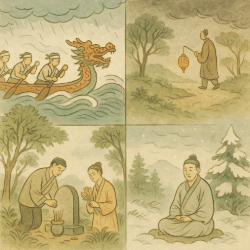Introduction
When the Taoists speak of weather, they are not speaking of something outside of us. Wind, rain, cloud, and drought are the same currents that move in our own breath, our moods, and our destiny. To watch the sky is to watch the Tao, vast and shifting, a mirror of life’s balance.
This pillar explores how Taoism has understood weather across its long history. From the rituals of early China to modern reflections on climate change, weather has been seen not only as a matter of survival but as a sign of cosmic order.
Weather in Early Taoist Thought
Weather as Omen
In early Chinese history, weather was bound to politics. If Heaven favored a ruler, rains came on time, crops grew, and winds blew gentle. If floods or drought struck, it was said the Mandate of Heaven had shifted.
Taoists read these same events with different eyes. Rather than only a judgment of kings, weather was a lesson in alignment. The Tao itself revealed through cycles: when yang heat pressed too long, storms followed; when yin cold deepened, spring was waiting in silence.
Weather in the Huangdi Neijing
The Yellow Emperor’s Inner Classic, a foundational Taoist medical text, describes health as harmony with climate.
Wind invades the body, bringing sudden illness.
Dampness lingers, causing heaviness in the limbs.
Dryness cracks the skin and lungs.
Cold blocks movement and circulation.
Heat stirs fevers and restlessness.
Thus, to treat illness was often to treat weather within.
Taoist Cosmology of Weather
Yin and Yang
At its most elemental, weather reflects the dance of yin and yang.
Clear, bright days lean yang.
Mist and rain lean yin.
Thunderstorms reveal the clash and balance of both.
Taoist poetry often compares the human heart to a valley waiting for rain, or the human spirit to a clear sky after storms.
The Five Phases
Weather also maps onto the Five Phases (wuxing):
Wood (Spring, Wind): rising energy, sprouting life.
Fire (Summer, Heat): blazing sun, thunderstorms.
Earth (Late Summer, Humidity): mists, clouds, damp ground.
Metal (Autumn, Dryness): crisp skies, falling leaves.
Water (Winter, Cold): snow, ice, still rains.
This cosmology gave Taoists a system for understanding both nature’s changes and the body’s rhythms.
Weather as Teacher
For Taoists, the sky was not hostile. It was a teacher.
Clouds: concealment and transformation, reminding us that clarity often hides behind veils.
Wind: unseen yet powerful, teaching the importance of what moves quietly.
Rain: both blessing and flood, urging humility before abundance.
Thunder: sudden awakening, a call to attend.
Laozi himself used weather images: “The highest goodness is like water.” Zhuangzi, too, described the “great wind” as the breath of Heaven, moving freely without preference.
Taoist Rituals and Weather Control
Weather was not only observed but addressed. Communities turned to Taoist priests in times of drought or storm.
Ritual Rainmaking (Qiuyu)
During drought, Taoist masters led rainmaking rituals:
Priests fasted and purified themselves.
Sacred talismans were burned or floated on water.
Incantations summoned dragons, the rain-bringers of Chinese myth.
Sometimes success brought fame; sometimes failure brought exile.
Sect Approaches
Celestial Masters: public rites to stop floods or summon rain, often tied to community survival.
Lingbao School: cosmological rituals aligning human needs with celestial deities who governed weather.
Quanzhen: more inward, teaching that to regulate breath and internal qi was to harmonize with external climates.
Weather in Daily Life
Feng Shui and Weather
Feng shui masters watched wind and water carefully. A house placed facing bitter winds was unlucky; one near a soft river bend prospered. Weather was not temporary but structural, shaping the life of a place for generations.
Agricultural Calendars
Chinese farmers relied on Taoist-inspired almanacs, dividing the year into 24 seasonal nodes (jieqi). Each node marked a change in sun and sky, guiding planting and harvest.
Festivals
Taoist holy days often coincide with solstices and equinoxes. The Spring Festival, Dragon Boat Festival, and Mid-Autumn Festival all mark seasonal transitions, honoring weather’s role in human fortune.
Symbolism in Taoist Literature
Taoist texts use weather not as backdrop but as central metaphor:
Zhuangzi tells of the great Peng bird, carried thousands of miles by wind, symbol of vast freedom.
Taoist poetry from the Tang dynasty describes sages as clouds drifting without attachment, or as rain falling without claim.
Qi Gong manuals speak of cultivating breath like the spring wind or storing qi like winter water.
Weather is thus both external fact and inner guide.
Comparative Perspectives
Taoism shares weather reverence with other traditions, but with a unique tone.
Shinto (Japan): storms as kami, sacred beings.
Hinduism: Indra as bringer of monsoon rains.
Native American traditions: clouds, sun, and wind as ancestors or teachers.
Where others may seek command, Taoism advises attunement. To bend with the storm is stronger than to resist it.
Weather in Taoist Medicine and Practice
The Six Climatic Qi
Taoist medicine identifies six climatic influences (liuyin):
Wind, Cold, Summer-Heat, Dampness, Dryness, Fire.
These are not just weather but pathogenic forces. To guard health is to guard against excess exposure to any.
Qi Gong and Internal Weather
Practices of breathing and movement often mirror weather cycles. One learns to:
Breathe like wind through pines.
Gather qi like dew.
Sink energy like heavy rain into soil.
Internal weather becomes a way to harmonize body with sky.
Modern Reflections: Taoism in a Changing Climate
Today, we face not only storms but a changing climate of our own making. Taoist lessons speak with new urgency:
Do not overdraw from nature. Excess yang always invites yin collapse.
Conserve and adapt. Like water, yield yet endure.
See the larger cycle. Humanity is not apart from weather but within it.
Taoism does not offer control, but orientation. Its counsel is patience, humility, and harmony in the face of shifting skies.
Conclusion
Weather, in Taoism, is more than condition of the sky. It is teacher, omen, healer, and mirror of the Tao. From ancient rituals to modern reflection, Taoists have sought to live not against the sky but with it.
The clouds above, the winds that rise, the rains that fall—they are the Tao’s voice, whispering balance, inviting us to walk in step with Heaven and Earth.
Taoism & Weather — Frequently Asked Questions
What role does weather play in Taoism?
Weather mirrors the Tao—the changing balance of yin and yang. Clouds, wind, rain, and drought are read as patterns to align with rather than forces to conquer.
Did Taoists try to influence the weather?
Yes. Historical records describe ritual rainmaking (qiuyu) and flood‑calming rites, especially in the Celestial Masters and Lingbao traditions. These were community‑oriented and paired with fasting, purification, and talismans.
How do yin–yang and the Five Phases relate to weather?
Clear heat, storms, mists, crisp skies, and winter cold map to Fire, Earth (humidity), Metal (dryness), Water (cold), and Wood (spring wind). Yin–yang describes their ebb and flow through the seasons.
What are the “six climatic qi” in Taoist/Chinese medicine?
Wind, Cold, Summer‑Heat, Dampness, Dryness, and Fire. Health practice emphasizes avoiding excess exposure and adapting habits to seasonal conditions.
Is feng shui connected to weather?
Yes. Classic siting considers prevailing winds and water flow. Sheltered aspects and gentle breezes are preferred; harsh wind corridors and stagnant moisture are avoided.
Which Taoist festivals align with seasonal changes?
Observances cluster around solstices, equinoxes, and the 24 seasonal nodes (jieqi), reinforcing ritual harmony with shifts in light, temperature, and rainfall.
How does Taoism inform responses to modern climate change?
Taoist ethics favor restraint, conservation, and adaptive design—“move with the water, not against it.” It emphasizes systemic thinking and long‑cycle stewardship.
How can I apply Taoist seasonal alignment in daily life?
Adjust routines with the seasons: lighten activity and rise early in spring; work and recover in balance during summer heat; simplify and dry in autumn; conserve warmth and rest in winter. Practice mindful breathing and walking outdoors to “read” the day’s sky.



